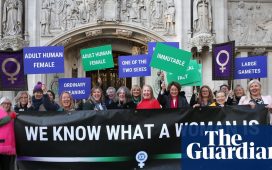This is the final installment of a three-part series exploring how the archdiocese of New Orleans’s bankruptcy stands apart from other cases of its kind. The first installment ran on Wednesday 29 November 2023, and the second installment ran on Friday 1 December.
Call her Sheila.
She doesn’t want her name used because of court testimony she has given as a state social worker which helped put men who abused their families in jail. She’s retired now, but still a rescuer by nature.
On a recent afternoon she went back to Madonna Manor, the Catholic orphanage in a Spanish colonial revival building, now shuttered, several miles across the Mississippi River from New Orleans. “A reverent place,” she sighed, “but it’s also a crime scene.”
She gazed at the wooden plank covering a window. Raccoons now nested in rooms that were once the dormitory for boys under age 12 at Madonna Manor. Feral cats roamed the empty playgrounds where homeless men sometimes camped.
“I tried. I did everything I could to get that man put away,” she said, referring to Harold Ehlinger, who lived in a dormitory room when her day job was counseling boys at Madonna Manor decades ago.
On the opposite side of Barataria Boulevard, another Spanish mission structure housed the older, adolescent boys: Hope Haven, a name dripping with irony like candle wax given the hell described in victims’ lawsuits against the New Orleans archdiocese.
The buildings warped by neglect stand on vast green acreage – potentially sizable assets in the bankruptcy protection this archdiocese sought in 2020, facing abuse victim lawsuits. The church case now exceeds 500 abuse claims, whose potential value depends on the survival of a recent Louisiana “look-back” law which eliminated filing deadlines for victims.
The outlines of a subterranean criminal religious culture are emerging with roughly 100 abuse claims that center on the two orphanages.
The severity of suffering at Hope Haven and Madonna Manor probably explains why 23 of those claimants, already some of society’s most vulnerable and marginalized, have had legal troubles and been incarcerated – their cases are among those brought by the law firm of New Orleans trial attorney Frank E Lamothe.
“People escaped – sometimes in groups,” said a former resident, not among Lamothe’s clients, with his own lawsuit against the orphanages pending, under a pseudonym.
Call him Leon. Born in 1971, he was sent to Madonna Manor from a splintered family in late 1982 or 1983 – he’s blurry on exactly when. “Instead of taking abuse I’d run away – too many times to count,” he said. “Police would bring you back. It was pretty much a prison.”
A religious brother named Harold Ehlinger is accused of child sexual abuse in several lawsuits pending against the church and Catholic Charities, which ran the two facilities, while utilizing public funds from the United Way and local government.
In the fall of 1980, Sheila had a freshly minted master’s in social work from Tulane University when she went to work at Madonna Manor. In counseling and group therapy she discovered boys angry, cynical and acting out over sexual abuse by Brother Harold in his private room within the dorm. The boys agreed to give her statements – she taped interviews.
When Sheila rapped on his door, Ehlinger answered in a bathrobe, with a flustered child inside. Ehlinger was “furious at seeing me”, she recalled.
She told her supervisor. The supervisor had her meet with a priest who listened gravely and accepted her documentation. Ehlinger disappeared. She was relieved. In 1982, she took a better-paying job with the state of Louisiana.
Sheila the whistleblower had gone when Leon arrived. Church authorities had allowed Brother Harold to reside in a cottage near Hope Haven.
“Brother Harold was like the boss,” Leon continued. “Once you’re targeted they got lockdown units. They’d put a pillow over your face so you can’t hear what’s going on. Sometimes they wore masks to conceal [their] identity so you didn’t know who raped you.
“They’d bring you over to the Dark Tower – that’s what we called the church, the cathedral they had on the property. Running away from Madonna Manor you just wanted to be someplace else. You’re still going to an abusive environment, but it was the horrors of being sexually assaulted, like the devil was in the building.”
Leon’s lawsuit alleges beatings and sexual assaults by several men. “Brother Harold performed some form of fondling, groping or molesting of [Leon] on an almost daily basis,” the complaint alleges.
“When I got out,” he told the Guardian, “I was damaged goods.”
In the mid-80s, Sheila was driving past a Catholic school. She saw Ehlinger, surrounded by kids, guiding them into school buses. She was stunned. “I naively thought they’d turned him over to the police or kicked him out of ministry.”
Ehlinger was one in a procession of alleged pedophiles at Hope Haven and Madonna Manor, according to various pending lawsuits, depositions and documents from past cases not subject to bankruptcy judge Meredith Grabill’s secrecy order concealing church documents.
Collectively, those documents provide new, chilling particulars about two of the most infamous institutions linked to the Catholic clergy abuse crisis – but whose details have largely been buried in the past.
Ehlinger’s last known address is a Holy Cross religious house in Austin, Texas. A process server went to hand him legal papers there.
Ehlinger is among the more than 200 accused Catholic church abusers not on the local archdiocese’s “credibly accused” list, though the church resolved past cases identifying him in what became negotiated settlements.
The church declined the Guardian’s request for an interview with Archbishop Gregory Aymond or to answer general questions about this report.

Haunted by nuns
Call him Joe. His lawsuit against the church uses a pseudonym.
In 1976, when he was 11, Joe went to Madonna Manor. He noticed that the pool was closed.
“I was told one of the students drowned in the pool,” he said. “I never knew the boy’s name, only that he snuck out one night and died in the pool.”
Joe said he started wondering about the boy’s death after Sister Martin Marie began “tying me by the genitals and nearly suffocating me to sexually pleasure her between the legs”.
“She liked to sit on my face till I couldn’t breathe,” he remarked.
To this day, he said, he wonders about whether the boy who was said to have drowned may have been abused.
Martin Marie, a member of the School Sisters of Notre Dame, was named in an earlier wave of lawsuits over the orphanages in 2009. Like Ehlinger, her name is not on the archdiocese’s credibly accused list.
Joe finds that appalling because he says Sister Martin Marie wasn’t the only nun complicit in the beatings and sexual abuse he endured on the verge of puberty.
“I kept running away from Madonna Manor because of those nuns,” Joe said. “They sent me back to my mom and stepdad in Metairie. Things didn’t go well for me after Madonna Manor. My mom didn’t believe me about the nuns.”
Joe said he was committed to a mental hospital in Mandeville, a community across Lake Pontchartrain from New Orleans. He recalled being treated with the anti-psychotic medication thorazine. “I didn’t trust people,” he said. “I became very violent, I did fight the staff.
“I was held down, injected and put in restraints.”
He got out. After scrapes with the law he found a foster father, and slowly began rebuilding his life.
“I’m in a safe place now,” Joe said.
For many years he avoided Madonna Manor. But on a recent autumn day Joe gave a work buddy, who lived near the complex, a lift home. He found himself on Barataria Boulevard, and the memories started surging. He parked at the back of the Madonna Manor dormitory.
He found Sheila standing there.

Sheila saw the pain on his face and knew in a heartbeat he was a survivor. Like her, she sensed, he had left a piece of his heart there. Thinking of the boys she had tried to help, she stepped toward him and said: “Hi, I’m Sheila.”
“I’m Joe,” he replied. “I used to live here.”
She was a stranger but within a few minutes he was pouring out stories of his past – did she know about the boy who drowned? She did not. Sheila took the Madonna Manor job four years after Joe left. They exchanged phone numbers. He called her that night, sobbing as he let loose memories of the hell he survived, wondering if that boy who was rumored to have drowned was a victim like he was, only worse.
Joe continued by sharing details about his best friend at Madonna Manor, an altar boy who was molested by a priest.
The boy, Rene Perez, was eventually moved to another home across the lake.
“He and two or three others had run away,” Joe said. “They took bicycles and were going across [a] bridge when he got hit by a car and thrown in the water. They found him I think about five days later.
“The funeral was held at Madonna Manor church, but I wasn’t there that weekend.”
Still fighting tooth and nail
In the 1920s, Hope Haven opened as a home for dependent children. Madonna Manor opened a few years later. Eventually boys younger than 12 lived at Madonna Manor, and older teenagers at the other institution.
Exactly when the two institutions became a magnet for pedophiles and people prone to sadistic behavior is unclear. But 17 lawsuits filed in 2005 made allegations going back to the 1950s that described horrific abuses.
Besides the School Sisters of Notre Dame, other authority figures at the orphanages were Salesian priests and brothers, who founded the nearby Archbishop Shaw high school.
A major figure in the 2005 litigation, a priest named Ray Hebert, was director of the two facilities from 1966 to 1971.
Hebert, who held the elevated title of monsignor, was also the director of Catholic Charities, which had responsibility for the orphanages. If any cleric had textured knowledge of the internal dynamics at the two facilities, it was Ray Hebert.
In 2008, during the litigation, Hebert gave a deposition, saying: “If you were a trained social worker, you didn’t speak of orphanages.” Institutions for dependent children was more correct, he said, because state funding was involved.
Yet the survivors of the sexual and physical abuses may as well as have been on another planet from most of society. Most came from dysfunctional families and lacked any freedom to leave on their own, other than by running away, which invited retribution.
Hebert in the early 1990s took another job, as vicar of clergy at the New Orleans archdiocese, a position that required him to investigate priests accused of child sexual abuse.
Attorney Michael Pfau, who represented plaintiff-survivors of the orphanage, asked if Hebert ever reported a priest to the police or child protective services.
“No,” he answered. “I never did.”
Hebert stated that after interviewing a given priest, he sent a report to his boss at the time: the longtime archbishop Philip Hannan.
Pfau asked: “Did you ever ask a priest to sign a written statement?”
Hebert replied: “No, not that I remember. I recall one case, you know, where after interviewing the [priest] and taking notes, I did ultimately write up a report as to what I had learned from him, and asking him to go over the report to see whether he objected to anything I had put in that report not being accurate. But I didn’t ask him to sign this report.”
On retiring from that job in 2003, Hebert said he destroyed all his notes.
Doing so was a serious violation of canon law, according to Tom Doyle, a former priest and canon lawyer in the Vatican embassy in Washington DC in the early 1980s. Canon 1719 reads: “The acts of the investigation, the decrees of the [bishop] which initiated and concluded the investigation, and everything which initiated and concluded the investigation, and everything which preceded the investigation are to be kept in the secret archive of the [administration] if they are not necessary for the penal process.”
How many reports Hebert actually wrote is unknown. But his 4 November 1999 assessment of Father Lawrence Hecker was made public, in a recent filing by the Orleans parish district attorney’s office, after his criminal indictment.
The document is notable for Hecker saying he harassed or slept with various boys but did not have sex. Hecker does, however, concede that a young man “came out, years later, he told his parents that he and I had had sex together. They reported this to … Hannan and he spoke with me about it in early 1988.”
By 2012, when Sister Carmelita Centanni, the archdiocese’s victim assistant coordinator, wrote to Archbishop Aymond, she cited an allegation of sexual abuse against Hecker from the police in Gretna, a New Orleans suburb, stating: “This is the NINTH allegation we have on record against Larry Hecker.”
Hecker retired with the comfort of a church pension until it was discontinued after the New Orleans archdiocese’s bankruptcy. He has been in jail awaiting trial since his indictment in September.
In the 2005 Hope Haven-Madonna Manor litigation, three plaintiffs mentioned Hebert among other accused abusers. Hebert responded by filing his own lawsuit against the plaintiffs, alleging defamation and denying he ever abused anyone.
Two other plaintiffs also named Hebert among other abusers but had not filed suit at that stage. Ultimately, after the archdiocese settled the Hope Haven-Madonna Manor litigation for $5m, the plaintiffs who named Hebert withdrew their claims against him.
Religion News Service revealed a bitter divide at the time of the settlement. Some involved in the settlement wanted the church to be required to release all documents pertaining to abuse at Hope Haven and Madonna Manor, but that didn’t happen.
“We’ve had to fight the church tooth and nail for more than four years to get [the church] to acknowledge wrongdoing,” said attorney Roger Stetter, who also had clients in the litigation. Stetter accused the archdiocese of trying to hide evidence.
Archbishop Gregory Aymond, who was recently installed at the time, seemed conciliatory. “It’s important that these wrongdoers come to light and that we admit that as far as we can tell [the charges] are true,” he said.
But the church went on to underreport its list of abusers.
Between 2010 and 2020, the archdiocese settled more than 130 sex abuse claims, totaling $11.7m, in many cases requiring victims to sign confidentiality agreements – a move specifically denounced by the 2002 US bishops’ youth protection charter.
Hebert died in 2014. Several years later, there was a new wave of lawsuits against Hope Haven and Madonna Manor after Aymond published a list of New Orleans Catholic clergymen whom his archdiocese considered to be credibly accused of child molestation.
In January 2020, the archdiocese paid $325,000 to resolve a case that accused Hebert, Sister Martin Marie and others with ties to Hope Haven as well as Madonna Manor. The archdiocese would not pay such settlements if it didn’t consider claimants believable, as one of the organization’s vicars general told an abuse survivor in a separate case.
But Hebert’s name is conspicuously absent from the archdiocese’s credibly accused list, which has been updated several times since it was first published in 2018.
The issue no one wants to touch
Amid news of the later lawsuits, Joe contacted the attorneys John Denenea and Richard Trahant.
They told him the process could be long and frustrating. But he signed on.
After the bankruptcy began, Joe was surprised at the opportunity to serve on the creditors’ committee, representing other survivors and negotiating toward a settlement. He had few illusions about the church but wanted to help push against the rock of injustice.
Last year, he went to a scheduled meeting with Aymond, where he and three other survivors hoped to speak their truth directly to the archbishop. But then came word that Judge Grabill was removing him, Trahant, Denenea and three more of the lawyers’ survivor clients from involvement with the committee.
Grabill maintained that Trahant had violated a secrecy order by warning a local Catholic high school run by his cousin that the campus’s chaplain had a substantial stain in his past.
Trahant’s warning ultimately forced the archdiocese to disclose that the chaplain had engaged in sexual misconduct with a teenage girl at a past assignment in the 1990s but was allowed to continue his career.
“I think it was a setup by the church,” Joe said. He said his lawyers had long been after the records that vividly outline the abuses at Madonna Manor, Hope Haven and numerous other archdiocesan institutions across the New Orleans area, which serves about a half-million Catholics.
“The church doesn’t want to release that information,” Joe continued. “I think Richard [Trahant] was a patsy and they took us all out. That’s my take.”
The archdiocese’s formidable status in bankruptcy court leaves a trail of questions.
Given the public funds expended at Hope Haven and Madonna Manor, why haven’t federal authorities used their power to do a surgical review into every file archived at the archdiocese, including those detailing the abusive history of the two orphanages?
If Joe had cause to worry about whether a boy drowned there, and if his pal Rene Perez was the victim of a priest and died trying to escape another facility, what kind of oversight did Louisiana officials provide at Hope Haven and Madonna Manor?
Should the sadistic violence and rapes alleged by Leon be swept under the rug of time by the most powerful law enforcement authorities?
If Hebert, who oversaw the facilities, was in fact an abuser – as a $325,000 settlement would suggest – do documents shed light on his decisions that allowed the place to become a pedophiles’ haven, as alleged in the lawsuits?
How much do those 23 former Hope Haven and Madonna Manor residents who are now incarcerated know about what happened there?
Will Judge Grabill seal off information on crimes against children, as alleged in so many cases, to furnish a settlement when the church finally presents a reorganization plan?
More than half of New Orleans’s federal judges have recused themselves from archdiocesan litigation because of ties to the Catholic church.
This fact does not surprise Stephen C Rubino, a veteran plaintiffs’ lawyer who is now retired in Vermont. But that doesn’t mean Rubino – who spent many years in New Jersey litigating against the church – likes it at all.
“You should not be able to maintain a criminal racketeering conspiracy for hiding pedophiles and still function as a religious, tax-exempt charity,” Rubino – also a former Florida state prosecutor – said in response to the New Orleans archdiocese’s bankruptcy. “That is the issue no US attorney wants to touch.”
Ramon Antonio Vargas contributed reporting
-
In the US, call or text the Childhelp abuse hotline on 800-422-4453 or visit their website for more resources and to report child abuse or DM for help. For adult survivors of child abuse, help is available at ascasupport.org. In the UK, the NSPCC offers support to children on 0800 1111, and adults concerned about a child on 0808 800 5000. The National Association for People Abused in Childhood (Napac) offers support for adult survivors on 0808 801 0331. In Australia, children, young adults, parents and teachers can contact the Kids Helpline on 1800 55 1800, or Bravehearts on 1800 272 831, and adult survivors can contact Blue Knot Foundation on 1300 657 380. Other sources of help can be found at Child Helplines International











